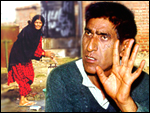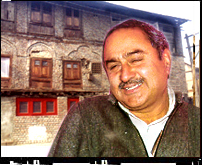What will it take to
bring Kashmir's migrant
Hindus home?
Chindu Sreedharan
Snug in a traditional Kashmiri pheran (a loose-fitting coat), 53-year-old Chamalal Razdan sits on the floor in his small living room.
"I never felt insecure," he volunteers. "Nobody has come to threaten me. The Muslims have only given me love..."
Razdan lives in Kajabagh, Baramulla. In case you need a reminder, the entire district was a hotbed of militancy. It still is. In 1990, threatened with what they have since dubbed 'ethnic cleansing' by Islamic fundamentalists, thousands of Pandits fled the Kashmir valley. Baramulla was then a separatist furnace. Today things are not much different.
Yet, here's a Pandit who opted to live on in the volatile area. And says 10 turbulent years later that no, he never seriously considered migration.
"Ten families stayed back. Not one of us came to any harm," Razdan says. "My son was born here, he studied here. When I go out of town for 10-12 days I need not worry about my family. I know they are safe."
Yes, there were moments when Razdan too felt threatened. When he heard about Pandits being killed in Srinagar and other districts, he was frightened. But that scare passed in a few hours. There's no special threat to Pandits, he believes. Not in Baramulla town.
"If there really was threat, I wouldn't be here," he says. "There was a panic in 1990. People left because they saw others leave."
Was that how it was? Hirdey Nath Ganju, who returned home after six years in a Jammu relief camp, doesn't agree. But he is one with Razdan about the amity shown by Muslims.
"When we returned in 1996 the entire town turned up to welcome us," he says.
That news, however, does not reassure the bulk of migrants.
Not 46-year-old Chamalal Pandita, for instance.

Once he used to live in a three-storeyed bungalow with 20 rooms. Now at a relief camp in Jammu, more than 350km from Baramulla, he shares a 12 x 9 feet room with five family members, a gas stove, some utensils, posters of a couple of Hindu gods, and a comfortless divan.
"Return where? Return to what?" he asks. "Our houses have been burnt. We are being killed... Yes, we would like to go back. But militancy has to end.
"If the government can't protect the Badami Bagh cantonment, what protection will we have?"
Leaf through Kashmir's history of insurgency. Stop when you reach September 14, 1989. You will see the first Pandit murder recorded there: Jia Lal Taploo's.
That murder can be explained away as political. Taploo was a Bharatiya Janata Party politician. For that reason alone, he was eligible to be killed as far as the militants were concerned.
The next was Neel Kanth Ganjoo. On November 4. His crime: as sessions judge he sentenced Jammu and Kashmir Liberation Front leader Maqbool Bhat to death.
The Pandits had by then started moving out. The euphoria following the release of five jailed JKLF militants gave the impression that Kashmir was about to break away from India. The minority members felt more insecure.
Then came 1990. The year brought with it Jagmohan as governor. Also, a series of murders. Among the Pandits killed were B K Ganju, Professor K L Ganju, Satish Tikoo, Sarwand 'Premi' Koul, Bhushan Lal Kaul, Bansi Lal Zutshi, Makan Lal Raina...
The Pandits' panic peaked. The exodus intensified.
When it ended, some 300,000 Hindus (and 70,000-odd Muslims) had migrated from the valley, mainly to Jammu and Delhi. The majority now lives in relief camps, on a monthly government dole of Rs 2,400 per family and some essential commodities.
Jagmohan, who is now a Union minister in the BJP-led government, comes in for scathing criticism here. He is said to have encouraged the migration.
"He wanted the Hindus out of the way so that he could unleash the army and the paramilitary on the Muslims," says a senior bureaucrat who served with Jagmohan. "But for him the exodus wouldn't have taken place."
This view, though well supported, is contested. Mainly by Panun Kashmir (Our Kashmir), an organisation fighting for a separate homeland for Pandits. There was a situation of terror, Panun Kashmir chairperson Dr Ajay Charangoo maintains, and Pandits were being specifically targeted. Get killed or get out was the choice.
Panun Kashmir sees a larger conspiracy in the attacks. The 'purely communal' operation, continues Dr Charangoo, was to cleanse the valley of Hindus.
"The battle (in the valley) is political and civilisational. It is not just for secession," he says. "The challenge is against the Indian civilisation. The pan-Islamic forces want to dismantle the northern frontier and Islamise the country. Forcing us out was the first move."
Charangoo's claim of 'purely communal' attracts criticism. "There were many Pandits killed during the initial days, true," says a keen Kashmir watcher. "But they were not killed just because they were Pandits."
Militants, he point out, were looking for targets with propaganda value. And the Pandits were just that. Besides belonging to a minority community, they were holding government jobs. To the militants this meant that they were the 'enemy'.
"If you look at the number of people killed you will find the percentage of Muslims far exceeding that of the Pandits," he says.
Charangoo's counter is: More Muslims were killed because there were no more Hindus left to be killed. By the middle of 1990 all the Pandits, bar a few, had migrated. But if you look at the statistics when they were in the valley, you would see that 95 per cent of those killed were Hindus.
"Once the cleansing was achieved the violence took different patterns," he adds. "There was politics, there were inter-group rivalries... it is in such incidents that the Muslims died. Because they were the only ones involved."
'They are traitors!' Read on...




